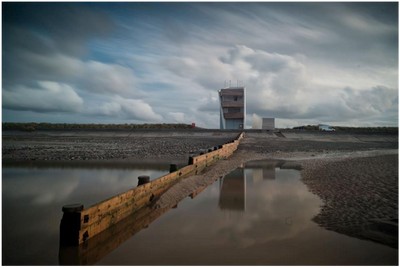Fleetwood – The horizon changes.
Fleetwood sits on the South West corner of Morecambe Bay. The bay is as treacherous as any around the British Isles having a tidal range of 10 metres, whilst the sand banks exposed at low water are uncovered for two and a half miles, always on the move leaving sand banks that rise above 2 metres in places. The gullies which intersect the banks, quickly fill as the tide returns, frequently cutting off the unwary. Most tragically this was witnessed in the recent deaths of the 23 Chinese cockle pickers.
In the beginning………………
The Lancaster Port Commissioners made a number of improvements to assist the navigation of ships operating in Morecambe Bay. The most obvious early improvement was the erection of the Fleetwood Landmark, in 1766 and the Walney Island Lighthouse in 1790.
The minutes of the Commissioners record 12th June, 1766. It was recommended at a meeting that a landmark would be most suitably erected at Fleetwood. Merchants of Wyre and Oversands write concerning the proposed Landmark and reply that they are willing to contribute a reasonable amount towards erecting the Landmark. The Landmark was to be 60 feet high from surface of the ground and 20 feet in diameter at the base, to be reduced in a regular manner to 6 feet at the summit. A calculation from one William Roper estimates the cost of the Landmark to be £137.
Little remains visible today, as modern navigational equipment has rendered such aids unnecessary.


In the early days before the present building, two buildings housed the Coastguard, including Fylde Court. This building still remains opposite the former Mount Vaults. In charge up to 1861 was a Captain Septimus Cowell, when the head quarters moved from Fleetwood to Morecambe.
Local Fleetwood fishermen, weather permitting, would go to sea on the inshore shrimp boats. When the weather deteriorated and they were unable to leave harbour, they would man the lookout to help subsidise their wages.
A 6 foot by 6 foot wooden hut was then situated more to the SW of the present station on the lower promenade. Watches for the local fishermen consisted of a 2 man watch for a period of four hours. Lookouts at the hut were only manned when the weather deteriorated to a force 5 or above. The hut contained basic equipment but much valued at the time was the rocket throwing lines for the breeches buoy. This equipment included a circular lifebuoy used by the Coastguard crews to extract seamen from stricken vessels that had run aground in heavy storms. Usually, a line was fired from a cannon onto the deck of the wrecked vessel. The Lyle Gun is a short barrelled cannon, designed to fire a projectile attached to a rope to the stricken vessel. This rope would be connected to a board called a Faking Line Box, a board with spindles along the end to keep the line fair and prevent it from fouling when the projectile is fired from the Lyle Gun.

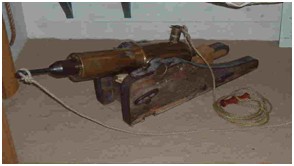
In 1948 the Government decided to rebuild the tower but this was only a small building and only on one level. The station was later converted to its present self and the full time coastguard was a Mr Bob Newson and he had 15 part time members. The new look station now had an extra level and gave a better panoramic view and had unrivalled facilities for its time. Directly opposite are many sandbanks where incidents occur almost daily during the holiday  season. In December 1991, a Government review of all coastguard stations nationally, concluded that the coastguard station at Fleetwood should close. Coastguard officials in London said that the beach at Fleetwood can be patrolled just as easily from a Landover. A campaign to save the lookout at Fleetwood got underway with over 1200 signatures collected in a space of a few hours. On Tram Sunday, a local Transport festival, a further total of over 5000 signatures were signed calling on the Government to think again about closing the lookout.
season. In December 1991, a Government review of all coastguard stations nationally, concluded that the coastguard station at Fleetwood should close. Coastguard officials in London said that the beach at Fleetwood can be patrolled just as easily from a Landover. A campaign to save the lookout at Fleetwood got underway with over 1200 signatures collected in a space of a few hours. On Tram Sunday, a local Transport festival, a further total of over 5000 signatures were signed calling on the Government to think again about closing the lookout.
The Department Of Transport said the reason for closure was because of new advanced technological equipment now available to the Coastguard service and that the majority of emergency calls received today are initiated by VHF radio. However, this obviously didn’t take into account that some small boats, dinghies, windsurfers and holiday makers do not carry VHF radios. Unfortunately there is no advanced equipment currently available which can spot stranded children on the sandbanks with a fast incoming tide.The Department of Transport closed the Fleetwood Coastguard lookout at Fleetwood in July 1994.
The NCI, formed in 1994, provides this service at no cost to the public purse, all year round and at over 46 former Coast Guard stations around the country. We are the eyes along the coast.
Whilst mobile patrols may be a more suitable option for some areas, with ever increasing number of craft and holiday makers using the bay, the use of the 30 foot high lookout station commands a wide view of the whole 5 square miles of dangerous sand banks in front of Fleetwood. Fleetwood has the second highest tidal rise and fall of anywhere in the country. It is impossible to see down into gullies between sandbanks from anywhere else in the area.
NCI and Fleetwood
In 2007, the NCI approached Wyre Bough Council with a view to leasing the building. Fleetwood continues to be one of the Britains leading places for spotting a variety of waders. Thousands of ornithologists visit the area every year. The tower had been used as a lookout for bird watchers but the building was left in a bad state of repair. Before NCI took over the premises it had been used as a storage space for the local authorities.
In spring 2008, NCI acquired possession and work began restoring it back to a lookout station. With the help from Fleetwood Nautical Campus and lecturers Tom Jowlett and MaryAnne Adams lessons on chart work, radar and radio began and NCI training modules were adopted.
When the station first opened, there were only sufficient members to cover weekends only, from 10am through till 6pm. Now with an increasing membership, week days are also covered. The station provides a working space free from harassment, with facilities including height, for extended views across the sand banks, powerful binoculars, charts, radios and Radar. The NCI also provides back up for the auxiliary coastguards handling an emergency. Since emergencies do not happen to order on hot days in summer, the service is available in all weather conditions, 24 hours a day, should this be required by HMCG.
Sea change – development in Fleetwood
Wyre Borough Council acquired funds from the EU, and from local business champion, Doreen Lofthouse, of Fishermans Friend Fame, to develop the sea front at Fleetwood, including the Marine Hall and Gardens and Rossall Tower. Work started at the Marine Hall in early 2011. Work started on Rossall Tower in December,
December 2011
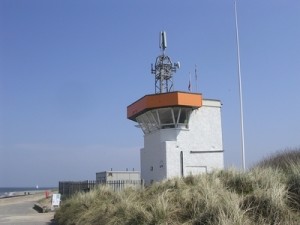
At the beginning of December, the old Orange communication mast, situated next to the old Coast Guard tower, was dismantled and moved to its new position, on the car park, about 400 metres away from its original position.

Over the Christmas period, the old tower looked forlorn and lonely, without the company of its less robust looking, metallic friend. However, the old tower, which had withstood all manner of storms, in fact, the best the Irish Sea could throw at it, was about to concede defeat to the demolition man’s machinery. After a distinguished career for HM Coastguard and latterly, with the National Coastwatch Institution, she was about to be part demolished and become a public toilet

Built around 1948, the structure was still sound, although with no running water, perspex windows, still in original metal frames, allowing the ever cool off shore winds to penetrate with ease, the members of NCI Fleetwood, were happy to see it updated.
January, 2012
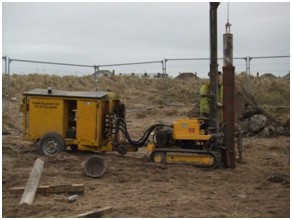
Work started on the new tower on January 9th, as the piling machines moved in. Piling down to around 8 metres, some vertical, some at an angle to take into account the lean of the tower, it is hoped that this stage will be completed by mid February.

The old tower was part demolished in early February, the observation deck and roof were removed.
February 2012
By mid February, the foundations were complete, the anchors for the steel work were clearly visible and the new septic tank was installed.complete, the anchors for the steel work were clearly visible and the new septic tank was installed


March,2012

Having removed the observation room from the top of the tower, it was time to complete its transformation. The plans for the old tower, was to turn it into an office for the Wyre Rangers, as well as a public toilet, operated by a private company, in the lower area. The roof was to become a viewing platform for bird watchers, Morecambe Bay and its environs, being an important migration area. Steps to the viewing platform were to be installed at the front of the tower.

By the end of March, the viewing area was tidied up and we were able to get our first photo of the new bird watching platform, at the top of the old tower. It was a good reminder of what we used to view whilst on a shift.
April,2012
Shortly after Easter, the giant crane arrived, ready to install the steelwork on the new tower. The promenade, which passes in front of the tower, was to be closed off, for Health & Safety reasons. The dog walkers and hikers would have to use the beach, or the footpath that ran alongside the golf course during very high tides.

The steel girders were removed from the back of the lorry and installed in place, the same day. This was to be the pattern for the next two weeks.The new tower was going to become a fixture on the Fleetwood landscape almost over night.

Within a few days, the new tower was starting to dwarf the old tower. The steel work glistened in the sun, a rare sunny day in an otherwise wet April. Fortunately, the wet weather didn’t hinder progress

The lean of the new tower was suddenly evident.
Quickly, the tower was taking shape. The full height of the tower was now clear and the lean seemed impossible. What will be our new observation centre, appears to overhang the promenade. The difference a day made the first photo from the 18th April, the second photo from the 19th.

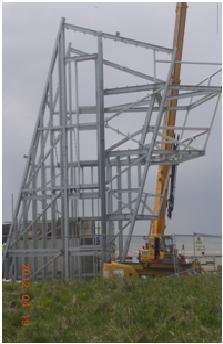
May, 2012

At the beginning of May, the steelwork was all but complete. The new staircase was installed and was clearly visible. Real Stairs !! It will be so different to climbing the steep metal ladder, we used to have, in the old tower. Probably a lot safer as well.
June 2012

The new tower resembled a giant Meccano set, an immense amount of steel work and a startling overhang for the Coastwatch team ! Early in June, the tower started to look like a tower as work on the external cladding started.
It took shape within a fortnight and we could finally see what our new home was going to look like. It was clearly taller than the other tower and the Coastwatch room was virtually hanging over the promenade.
Towards the end of June, one of the members was allowed after Health and Safety guidelines were followed the first sight of the interior of the tower and the Coastwatch room in particular. We got an idea of the view we will get, when on duty. We were also lucky enough to get a photo from the top deck, across to Barrow in Furness and down to Fleetwood. The end is in sight and our training was nearing completion, prior to the Fleetwood Nautical College closing for their summer break

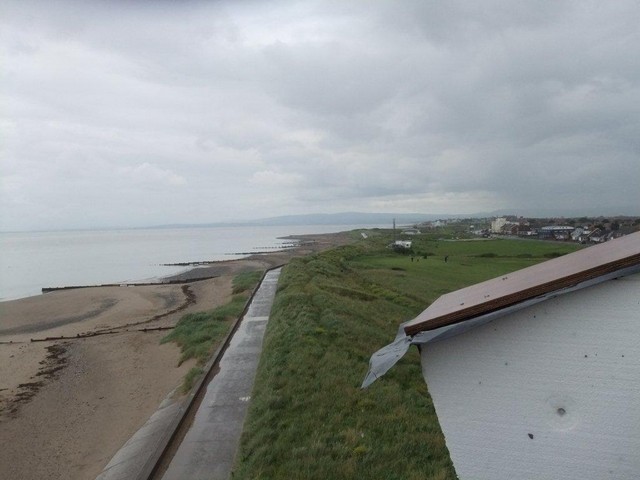
By the end of June, the cladding was almost complete and the windows are next. The tower will soon be ready for the first fix of the electrical works.
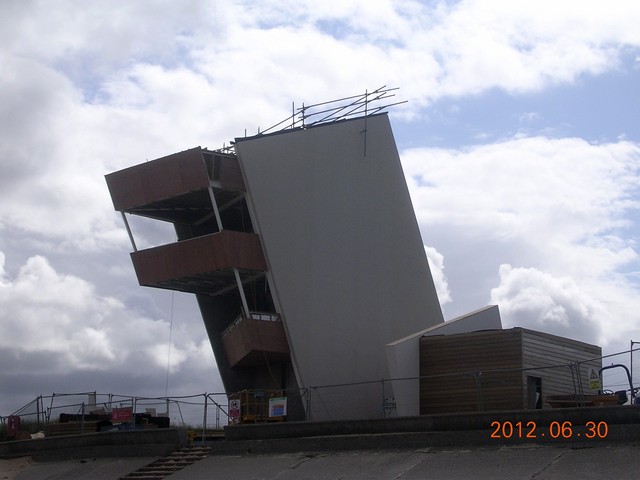
Next door at the old tower, that was also being clad in wood, making it unrecognisable from the cold, draughty concrete bunk house, it was before
July 2012
By mid July, the windows were installed double glazed, no less and it was clear, we would now have the best view in Fleetwood, of Morecambe Bay. The white render was also applied to the external walls


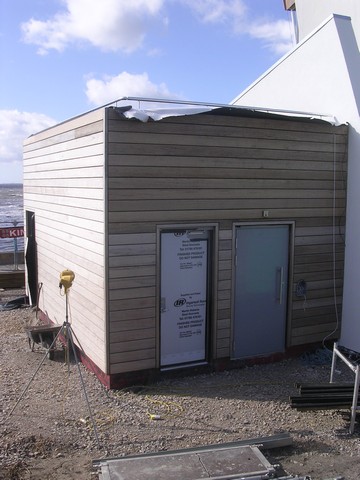
Our old tower was almost finished. The wood cladding, we are told, will weather fairly quickly and will soon look totally different. There are two doors, the wider one for access to the toilet, obviously disabled friendly. The narrower is for access to the Wyre Rangers office and store.
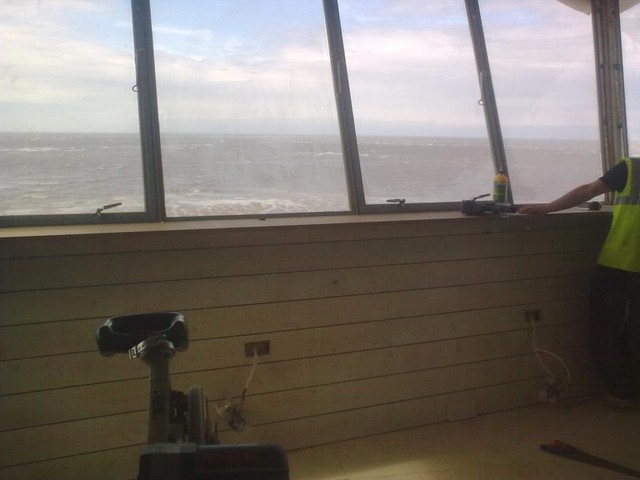
Towards the end of July, we had an update of the interior of the Coastwatch room, complete with internal cladding. The windows give impressive views across the Bay, even when dirty !
August 2012
Early August and we’re seeing the tower almost completely rendered. The first fix wiring, which proved so problematic because of the amount of steelwork in the building, was complete and internal renders were starting. The building was taking on a quite startling appearance because of the white render. We were told nobody would be able to miss it and they weren’t joking.

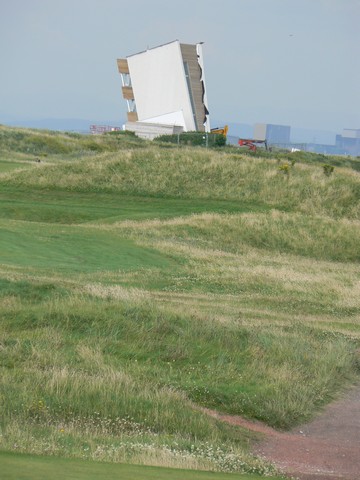
On the 4th August, a fabulous group of ladies, the Goal den Girls, presented a cheque for 6,000. uk pounds to Coastwatch. This was a result of many hours of training which culminated in them completing the Edinburgh Marathon, at the end of May. Coastwatch were just one of five local charities that benefited from their endeavours and generosity. They were as keen as Coastwatch members to look inside, but that will have to wait for another day. Coastwatch are hoping the tower will be handed over to them by the end of August. Then the work Coastwatch needs to do, fitting out with equipment and chart tables, can begin.

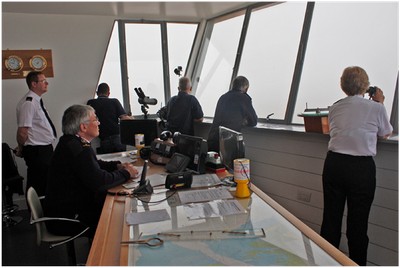 By the end of August, 2013, the interior of the tower had been fitted out. It was decided that a series of ‘dummy’ runs should ensure that all the equipment was operational, prior to going ‘live’ with Liverpool CG. The Watchkeepers also had to acquaint themselves with the new equipment. There was a substantial amount of training to arrange and everybody pulled together to help get through the difficult transition stage. The new desk in the tower was purpose built and looked impressive. We just had to make sure we all knew how it could benefit our watches.
By the end of August, 2013, the interior of the tower had been fitted out. It was decided that a series of ‘dummy’ runs should ensure that all the equipment was operational, prior to going ‘live’ with Liverpool CG. The Watchkeepers also had to acquaint themselves with the new equipment. There was a substantial amount of training to arrange and everybody pulled together to help get through the difficult transition stage. The new desk in the tower was purpose built and looked impressive. We just had to make sure we all knew how it could benefit our watches.
 Because the station had been closed for nearly two years, Liverpool CG also decided that an assessment of both Watchkeepers and equipment, was essential to ensure the highest standards were met and to provide confidence to the Search and Rescue services. The date was set for 28th September, so the pressure was on ! It was decided that Fleetwood RNLI and Fleetwood CG would arrange an exercise on the Bay and it would not only test our use of radio protocol, but would demonstrate to our SAR partners, that we would be an asset in an emergency. What’s more, Paul Ashworth , Cox of Fleetwood RNLI, arranged to record and film the whole exercise.
Because the station had been closed for nearly two years, Liverpool CG also decided that an assessment of both Watchkeepers and equipment, was essential to ensure the highest standards were met and to provide confidence to the Search and Rescue services. The date was set for 28th September, so the pressure was on ! It was decided that Fleetwood RNLI and Fleetwood CG would arrange an exercise on the Bay and it would not only test our use of radio protocol, but would demonstrate to our SAR partners, that we would be an asset in an emergency. What’s more, Paul Ashworth , Cox of Fleetwood RNLI, arranged to record and film the whole exercise.
On the day, Paul set up a camera in the tower and Fleetwood Inshore boat set off into the Bay. Within minutes, the mist came down and visibility reduced drastically. The exercise was in danger of being called off. However, after a short wait, the mist clear sufficiently for the exercise, code named Southpaw, to begin. The inshore boat sped across the water and threw a dummy ‘casualty’ over the side of their boat and continued. They then radioed in to the tower, to report a person in the water and it was the Watchkeepers job, to not only find the ‘casualty’ in the Bay, which was a difficult in itself, but to then guide the inshore boat, as quickly as possible, to recover the ‘casualty’.
The exercise was repeated 4 times, with the last ‘casualty’ being one of the lifeboat crew. The water was cold, they didn’t want to hang about in the Bay, a second longer than necessary! At the end of the exercise, the Coast Guard and RNLI discussed our performance and declared that they were satisfied with how we reacted to the incidents. We had passed ! We now had a Declared Facility Status.
National Coastwatch Institution’s Fleetwood station, was open for business once more.
Helping To Save Lives





